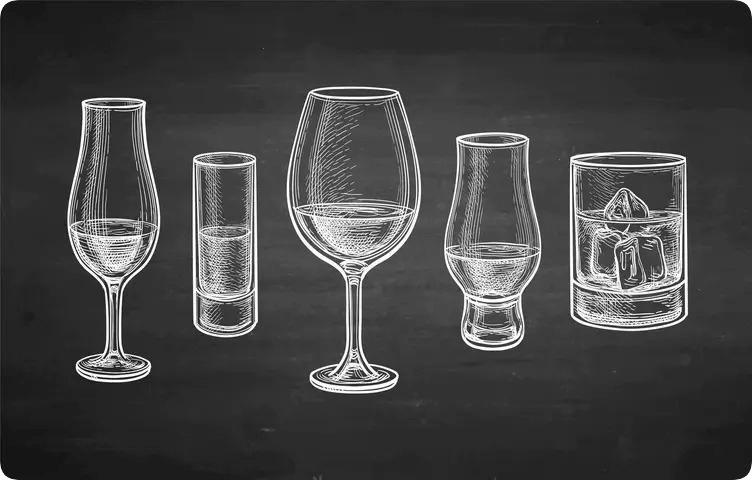Bar etiquette states that each type of alcohol corresponds to a specific glass. The serving method is especially important for whiskey, as it helps to reveal a rich palette of aroma. But stores offer a variety of glasses - tall and low, square and tulip-shaped. Let's figure out which dishes are more suitable for noble scotch and bourbon.
Whiskey glass shape
Expensive alcohol is judged by its combination of taste and smell. Proper serving of a drink helps to immediately assess its quality: color, consistency, strength. The dishes directly affect how the aroma is distributed.

Whiskey is traditionally poured into wide glasses. More than a dozen versions of this product are known. Here are the most common types:
Glencairn - characterized by a wide bottom and a smooth narrowing upward. According to the standard, it holds 50 ml of liquid. The shape of the cup ensures maximum saturation of the drink with air. Glencairn is suitable for shaking and drinking slowly. These types of vessels are used at whiskey tastings;
Tulip - resembles a Glencairn, but has a long stem, like wine glasses. Thanks to this, the connoisseur of the drink perceives the aroma gradually. Tulips are often used to serve cocktails containing whiskey;
Rocks is a low glass made of thick glass with a massive wide bottom. It is also called a tumbler or old-fashioned glass. It is usually round, but can also be hexagonal or octagonal. Rocks is considered a universal glassware for any strong drinks, including vodka, cognac, tequila;
Highball – the name translates as “high bowl”. The product has the shape of a cylinder with a thickened bottom. Standard capacity is 270 ml. Highball glasses are usually served with whiskey and soda or lemonade. The large volume allows you to put a lot of ice on the bottom, so tall glasses are often used for low-alcohol cocktails, so-called long drinks;
A shot is a small vessel with a thickened bottom of a square, cylindrical or triangular shape. The volume of the stack is 30-60 ml. Initially, vodka was served in shots, but gradually they began to be used for all types of alcohol, which were drunk in one gulp. Such products are popular in bars as they help bartenders control the number of portions;
A “neat glass” is a convex vessel that tapers inward. This unusual version appeared in 2002. The first neat glass was mistakenly made during a glass blowing class. It soon became clear that its shape perfectly reveals the aroma of whiskey without an alcohol trail;
Riedel is named after the company that produces glassware for wine. Together with Scotch whiskey experts, the company developed a convex glass with a wide base, reminiscent of a thistle flower. The product concentrates the aroma well and emphasizes the sweet flavors of the drink.
Modern manufacturers offer various forms of glasses: in the form of golf balls, tall glasses or tumblers with a figured bottom. The most interesting version of recent years, according to experts, has become a crystal wine glass without a bottom, reminiscent of a cut diamond.
What to look for when choosing
According to tradition, glassware for whiskey should be durable even in appearance. The most durable material is crystal glass. It looks beautiful on the table and can last for decades. Crystal is expensive, so glassware is often purchased for the home. A more durable option is glasses made of tempered glass with thick walls.
You can also find metal, wooden and plastic wine glasses in stores. Such products do not fully reveal the aroma of the drink and may impart extraneous flavors.
In addition to material and shape, consider comfort of use. The product should be massive, but not too heavy for the hand. Also pay attention to the thickness of the walls - it is inconvenient to drink from a container with an excessively thick edge.
When choosing whiskey glasses, also find out the care features: can they be washed in the dishwasher, or do they need a special storage container.
An important criterion is the price of the dishes.
Features of whiskey glasses
When tasting alcohol, three key elements are important: aroma, taste and aftertaste. To truly enjoy it, you need to feel the texture of the drink, as well as the feeling that lingers in your mouth and throat after sipping.

Shape of glassesplays a special role in the perception of volatile substances contained in alcohol. If we smell well, the taste is also enhanced. Here's why you need to consider the type of whiskey when choosing a glass:
Wheat - almost odorless. Shot glasses are suitable for it, creating an emphasis on taste characteristics;
Malty – has a pronounced aroma. It goes well with Glencairn or tulip glasses, which maximize the aroma of the drink;
Mixed – varieties made from a mixture of grain and malt are best perceived in rocks glasses and “neat” glasses. This shape supports optimal perception of taste characteristics;
Corn (bourbon) – has a spicy taste. To experience it to its fullest, serve the bourbon in tumblers widened at the top. The large diameter of the dishes helps to quickly dissipate the alcohol smell.
An important feature of whiskey glasses is the ability to keep the drink cold for a long time. The thickened bottom or high stem protects the container from the heat of your hand. But if you prefer drinks without ice, choose highballs with a thin bottom.
Care and storage of whiskey glasses
Insufficiently clean dishes retain foreign tastes and odors that spoil the impression of the drink. The surface of the glass, although it seems smooth, is covered with microscopic pores that absorb dirt. This is why whiskey glasses are washed immediately after consumption.
The rules of care are quite simple:
- wash glasses with hot water, then rinse with cold water;
- Remove stubborn stains with a non-aggressive detergent;
- use only soft rags and sponges, without abrasive particles;
- wipe the glasses dry with a cotton towel;
- After washing, place the glasses upside down on a wooden surface to dry completely.
Do not wash glasses in the dishwasher unless the instructions say so. High temperatures and aggressive detergents used in machine washing gradually make the glass cloudy, leading to cracks and chips.
If the dishes retain a persistent smell of whiskey even after washing, soak them for 5 minutes in warm water with the addition of 1-2 tablespoons of 9 percent vinegar. Then rinse thoroughly with a clean sponge and dry with a towel.
Store whiskey glasses in a dry, dark place. Moisture causes stains on dishes, and sunlight discolors colored glass. Do not stack glasses on top of each other - this method of storage will cause scratches. Place items in a box or place them on a tray and put them away in a closet.
Check your glasses regularly for chips and cracks. Defects can detract from the taste of the whiskey, especially if the glassware is made of colored glass or crystal. It is better to replace a damaged glass immediately.
















































/https%3A%2F%2Fcomplexbar.com%2Fimages%2Fblog%2F132%2FWhiskey1-2.png)
/https%3A%2F%2Fcomplexbar.com%2Fimages%2Fblog%2F246%2Fsirop_scale_2400.jpeg)
/https%3A%2F%2Fcomplexbar.com%2Fimages%2Fblog%2F246%2Fkofe-vostochniy.jpg)
/https%3A%2F%2Fcomplexbar.com%2Fimages%2Fblog%2F245%2Fpexels-jason-villanueva-851555.jpg)
/https%3A%2F%2Fcomplexbar.com%2Fimages%2Fblog%2F246%2F2024-04-09_17.22.54.jpg)
/https%3A%2F%2Fcomplexbar.com%2Fimages%2Fblog%2F246%2F2024-04-09_17.22.47.jpg)
/https%3A%2F%2Fcomplexbar.com%2Fimages%2Fblog%2F246%2FCODE_anons_foamydrops_752%D1%85480_eng.jpg)
/https%3A%2F%2Fcomplexbar.com%2Fimages%2Fblog%2F246%2FAlina_752%D1%85480_eng.jpg)
/https%3A%2F%2Fcomplexbar.com%2Fimages%2Fblog%2F246%2F2024-04-09_17.23.22.jpg)
/https%3A%2F%2Fcomplexbar.com%2Fimages%2Fblog%2F246%2F2024-04-09_17.23.28.jpg)
/https%3A%2F%2Fcomplexbar.com%2Fimages%2Fblog%2F246%2F2024-04-09_17.23.35.jpg)
/https%3A%2F%2Fcomplexbar.com%2Fimages%2Fblog%2F246%2Fdrinksome_752%D1%85480_eng.jpg)
/https%3A%2F%2Fcomplexbar.com%2Fimages%2Fblog%2F246%2Fnude_752%D1%85480_eng.jpg)
/https%3A%2F%2Fcomplexbar.com%2Fimages%2Fblog%2F246%2F752%D1%85480_eng__1_.jpg)
/https%3A%2F%2Fcomplexbar.com%2Fimages%2Fblog%2F246%2F752%D1%85480_eng.jpg)
/https%3A%2F%2Fcomplexbar.com%2Fimages%2Fblog%2F246%2FStudioRaw_752%D1%85480_eng.jpg)
/https%3A%2F%2Fcomplexbar.com%2Fimages%2Fblog%2F246%2FDoppio_tea_752%D1%85480_eng.jpg)
/https%3A%2F%2Fcomplexbar.com%2Fimages%2Fblog%2F246%2FTognana_Stars_Stripes_752%D1%85480_eng.jpg)
/https%3A%2F%2Fcomplexbar.com%2Fimages%2Fblog%2F246%2FRona_752%D1%85480_eng.jpg)
/https%3A%2F%2Fcomplexbar.com%2Fimages%2Fblog%2F246%2FDoppio_vending_752%D1%85480_eng.jpg)
/https%3A%2F%2Fcomplexbar.com%2Fimages%2Fblog%2F246%2FEssence_sukhie_smesi_752%D1%85480_eng.jpg)
/https%3A%2F%2Fcomplexbar.com%2Fimages%2Fblog%2F246%2FODK_sukhie_smesi752%D1%85480_eng.jpg)
/https%3A%2F%2Fcomplexbar.com%2Fimages%2Fblog%2F246%2Funiforma-barmena.jpg)
/https%3A%2F%2Fcomplexbar.com%2Fimages%2Fblog%2F246%2Fkak-nanyat-barmena.jpg)
/https%3A%2F%2Fcomplexbar.com%2Fimages%2Fblog%2F246%2Fsirop_scale_2400.jpeg)
/https%3A%2F%2Fcomplexbar.com%2Fimages%2Fblog%2F246%2FPeugeot_Anons_Paris_U%27Select_Line_Daman_752%D1%85480_eng.jpg)
/https%3A%2F%2Fcomplexbar.com%2Fimages%2Fblog%2F246%2Fkofe-vostochniy.jpg)
/https%3A%2F%2Fcomplexbar.com%2Fimages%2Fblog%2F246%2FMadler.jpg)
/https%3A%2F%2Fcomplexbar.com%2Fimages%2Fblog%2F246%2Fprofbartender_glavn.jpeg)